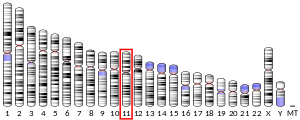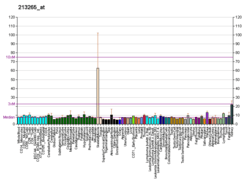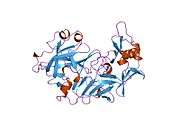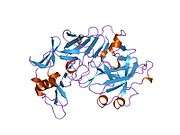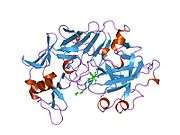PGA5
Pepsinogen A is a protein that in humans is encoded by the PGA5 gene.[3]
| PGA5 | |||||||||||||||||||||||||
|---|---|---|---|---|---|---|---|---|---|---|---|---|---|---|---|---|---|---|---|---|---|---|---|---|---|
 | |||||||||||||||||||||||||
| Identifiers | |||||||||||||||||||||||||
| Aliases | PGA5, Pg5, pepsinogen 5, group I (pepsinogen A), pepsinogen A5 | ||||||||||||||||||||||||
| External IDs | OMIM: 169730 HomoloGene: 68135 GeneCards: PGA5 | ||||||||||||||||||||||||
| |||||||||||||||||||||||||
| |||||||||||||||||||||||||
| |||||||||||||||||||||||||
| Orthologs | |||||||||||||||||||||||||
| Species | Human | Mouse | |||||||||||||||||||||||
| Entrez |
| ||||||||||||||||||||||||
| Ensembl |
| ||||||||||||||||||||||||
| UniProt |
| ||||||||||||||||||||||||
| RefSeq (mRNA) |
| ||||||||||||||||||||||||
| RefSeq (protein) |
| ||||||||||||||||||||||||
| Location (UCSC) | Chr 11: 61.24 – 61.25 Mb | n/a | |||||||||||||||||||||||
| PubMed search | [2] | n/a | |||||||||||||||||||||||
| Wikidata | |||||||||||||||||||||||||
| |||||||||||||||||||||||||
References
- GRCh38: Ensembl release 89: ENSG00000256713 - Ensembl, May 2017
- "Human PubMed Reference:". National Center for Biotechnology Information, U.S. National Library of Medicine.
- "Entrez Gene: PGA5 pepsinogen 5, group I (pepsinogen A)".
Further reading
- Ichinose M, Miki K, Wong RN, et al. (1991). "Methylation and expression of human pepsinogen genes in normal tissues and their alteration in stomach cancer". Jpn. J. Cancer Res. 82 (6): 686–92. doi:10.1111/j.1349-7006.1991.tb01904.x. PMC 5918501. PMID 1906854.
- Ichihara Y, Sogawa K, Takahashi K (1986). "Isolation of human, swine, and rat prepepsinogens and calf preprochymosin, and determination of the primary structures of their NH2-terminal signal sequences". J. Biochem. 98 (2): 483–92. PMID 2415509.
- Athauda SB, Tanji M, Kageyama T, Takahashi K (1990). "A comparative study on the NH2-terminal amino acid sequences and some other properties of six isozymic forms of human pepsinogens and pepsins". J. Biochem. 106 (5): 920–7. PMID 2515193.
- Hengels KJ, Strohmeyer G (1990). "Pepsinogens A and C: purification from human gastric mucosa and determination in serum by optimized radioimmunoassays". Zeitschrift für Gastroenterologie. 27 (8): 406–11. PMID 2609705.
- Evers MP, Zelle B, Bebelman JP, et al. (1989). "Nucleotide sequence comparison of five human pepsinogen A (PGA) genes: evolution of the PGA multigene family". Genomics. 4 (3): 232–9. doi:10.1016/0888-7543(89)90325-X. PMID 2714789.
- ten Kate RW, Pals G, Donker AJ, et al. (1989). "Tubular handling of pepsinogen A and C in man: evidence for two distinct tubular reabsorption mechanisms for low molecular weight proteins in man". Nephron. 53 (3): 223–8. doi:10.1159/000185748. PMID 2797342.
- ten Kate RW, Pals G, Eriksson AW, et al. (1989). "The renal metabolism of pepsinogen A and C in man". Clin. Nephrol. 31 (2): 103–6. PMID 2920466.
- Evers MP, Zelle B, Peeper DS, et al. (1987). "Molecular cloning of a pair of human pepsinogen A genes which differ by a Glu----Lys mutation in the activation peptide". Hum. Genet. 77 (2): 182–7. doi:10.1007/BF00272389. PMID 3115885.
- Pals G, Eriksson AW, Pronk JC, et al. (1989). "Differential expression of pepsinogen isozymogens in a patient with Barrett esophagus". Clin. Genet. 34 (2): 90–7. doi:10.1111/j.1399-0004.1988.tb02842.x. PMID 3191614.
- Foltmann B (1989). "Activation of human pepsinogens". FEBS Lett. 241 (1–2): 69–72. doi:10.1016/0014-5793(88)81033-0. PMID 3197840.
- Westerveld BD, Pals G, Bosma A, et al. (1987). "Gastric proteases in Barrett's esophagus". Gastroenterology. 93 (4): 774–8. PMID 3305135.
- Nakai H, Byers MG, Shows TB, Taggart RT (1987). "Assignment of the pepsinogen gene complex (PGA) to human chromosome region 11q13 by in situ hybridization". Cytogenet. Cell Genet. 43 (3–4): 215–7. doi:10.1159/000132324. PMID 3467902.
- Sogawa K, Fujii-Kuriyama Y, Mizukami Y, et al. (1983). "Primary structure of human pepsinogen gene". J. Biol. Chem. 258 (8): 5306–11. PMID 6300126.
- Fujinaga M, Chernaia MM, Tarasova NI, et al. (1995). "Crystal structure of human pepsin and its complex with pepstatin". Protein Sci. 4 (5): 960–72. doi:10.1002/pro.5560040516. PMC 2143119. PMID 7663352.
- Maruyama K, Sugano S (1994). "Oligo-capping: a simple method to replace the cap structure of eukaryotic mRNAs with oligoribonucleotides". Gene. 138 (1–2): 171–4. doi:10.1016/0378-1119(94)90802-8. PMID 8125298.
- Zwiers A, ten Dam MA, Crusius JB, et al. (1994). "The renal handling of pepsinogen A isozymogens in man". Clin. Nephrol. 41 (3): 153–8. PMID 8187358.
- Suzuki Y, Yoshitomo-Nakagawa K, Maruyama K, et al. (1997). "Construction and characterization of a full length-enriched and a 5'-end-enriched cDNA library". Gene. 200 (1–2): 149–56. doi:10.1016/S0378-1119(97)00411-3. PMID 9373149.
- Plebani M, Basso D, Navaglia F, DiMario F (1998). "Helicobacter pylori genotypes influence serum pepsinogen C levels". Helicobacter. 2 (4): 172–5. doi:10.1111/j.1523-5378.1997.tb00082.x. PMID 9421118.
- Strausberg RL, Feingold EA, Grouse LH, et al. (2003). "Generation and initial analysis of more than 15,000 full-length human and mouse cDNA sequences". Proc. Natl. Acad. Sci. U.S.A. 99 (26): 16899–903. doi:10.1073/pnas.242603899. PMC 139241. PMID 12477932.
- Ota T, Suzuki Y, Nishikawa T, et al. (2004). "Complete sequencing and characterization of 21,243 full-length human cDNAs". Nat. Genet. 36 (1): 40–5. doi:10.1038/ng1285. PMID 14702039.
This article is issued from Wikipedia. The text is licensed under Creative Commons - Attribution - Sharealike. Additional terms may apply for the media files.
